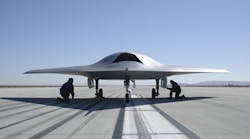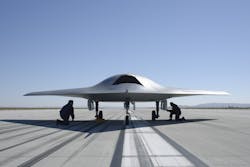California's Unmanned Aircraft Systems (UAS) Industry at a Crossroads
The California UAS Summit, held on Tuesday, June 10, 2014 in San Diego, brought together thought leaders from government, trade organizations, military, academia and a diverse mix of private sector companies to explore how California can continue to be a world leader in unmanned aircraft systems. Participants examined ways to support businesses in this industry while helping facilitate the FAA's initiative to integrate UASs into National Air Space in a safe and responsible way, while allowing for innovation and the development of new and exciting uses.
California is a center of excellence in the development, manufacturing, and testing of unmanned aircraft systems. From industry leaders General Atomics, Kratos Defense Solutions, and Northrop Grumman’s Center for Unmanned Systems headquartered in San Diego, as well as Boeing Co. and AeroVironment in Los Angeles county, major UAS companies have a history in California. With the addition of numerous small and emerging companies throughout the state, like 3D Robotics and AirCover Solutions, California is the world leader in taking UAS into the commercial space, developing innovative systems and advancing capabilities in preparation for integration.
Even though California ranks as the #1 UAS region, it was not chosen as one of the designated test sites by the Federal Aviation Administration in December 2013. The six selected operators are: the University of Alaska, the state of Nevada, New York’s Griffiss International Airport, North Dakota Department of Commerce, Texas A&M University, and Virginia Polytechnic Institute and State University. Geographic and climatic diversity were key requirements for the selection, and the test sites were to begin operation within 180 days of the announcement to conduct research to help the FAA develop regulations and operational procedures for the safe integration of UAS into national airspace.
The coalition to develop a UAS test range in California was headed up by an established entity called the California Unmanned Systems Portal (Cal UAS Portal), based in Indian Wells. The coalition expanded in April 2013 to include the AUVSI San Diego Lindbergh Chapter, the San Diego Regional Economic Development Council (EDC), the San Diego Military Advisory Council (SDMAC), the Imperial County EDC, County of Imperial, Holtville Airport, Indian Wells Valley Airport District (IWVAD), and defense contractors including General Atomics, Cubic Corp. and Epsilon Systems Solutions, Inc. The proposed UAS test site would have extended from the NAS China Lake/Edwards Air Force Area, west to the Pacific Ocean, south to the Mexican border and east to the Arizona border.
Currently, UAS are being used around the word for applications such as: aerial imaging/mapping, agricultural, Border Patrol surveillance, disaster management, environmental monitoring, law enforcement monitoring, oil and gas exploration, telecommunication, TV news coverage, sporting events, moviemaking, weather monitoring and wildfire mapping.
The summit’s keynote speaker was Gretchen West, executive vice president, Association for Unmanned Vehicle Systems International (AUVSI). She said AUVSI was started 42 years ago, has 30 chapters, and publishes two magazines, Mission Critical and Unmanned Systems, as well as a UAS directory and Robotics directory. AUVSI is active in public policy advocacy in Washington, D. C., and there is an Unmanned Systems Caucus in the House and Senate, as well as a Congressional Robotics Caucus.
She gave a brief overview of the UAS industry, and said that FAA integration is the key to expanding opportunities for UASs in the U. S. The bill mandating that the FAA safely integrate UAS into national airspace passed in February 2012, and safe integration is supposed to be completed by September 30, 2015. Until then, commercial applications of UAS are prohibited in the U. S. The selection of the site for the UAS Center of Excellence will be made in March 2015.
One of the major problems for the UAS industry is the negative -- and incorrect -- public perception of drones as immoral killing machines or intrusive spy machines hovering at our windows. Because of this misperception portrayed by the news media, several states have outlawed use of UAS by either private citizens or law enforcement or both, and several other states have pending legislation. These bans would prohibit use of UAS for many of the above listed applications and would inhibit the growth of commercial usage of UAS.
Large Manufacturers Advancing Unmanned Systems
Three panels of speakers followed West. Panel #1 was “Large Industry – Manufacturing and Production – Economic impact, jobs & industry growth.” The panelists were:
Christopher Ames, director, international strategic development, General Atomics Aeronautical Systems, Inc. – He said there have been 17 variants of General Atomics’ Predator over the past 20 years, logging over 2.8 million flight hours. The challenge is to have access to U. S. national airspace. GA-ASI is developing and testing an air-to-air sense and avoid system.
Jerry Beaman, president, Kratos Defense, Unmanned Combat Aerial Systems Division – His company is focused on a jet-powered UAS that will fill the high-performance, high-altitude market. Key features of their UASs will be the ability to operate in a contested airspace and a GPS-denied environment.
Albert Bosco, business development, Unmanned Airborne Systems, Boeing Co. - He said, “UAS aren’t a panacea, so we need to decide how, when and where to use them.” UAS use by first responders, environmental monitoring, and infrastructure monitoring may be major areas of focus.
Carl Johnson, vice president, Unmanned Systems, Northrop Grumman Corp. – Johnson provided the highlight of this panel by showing a video of Northrop Grumman’s Global Hawk X47B landing successfully on an aircraft carrier.
Panel #2 was “Commercialization of Small and Medium UAS – Balancing privacy with innovation.” The panelists were:
Jill Meyers, senior manager, 3D Robotics - She said that while their headquarters is in Berkeley, they have engineering support in San Diego, marketing and video production in Austin, Texas, and manufacturing in Tijuana, Mexico. They have three “copter” models and an airplane, and have a DIY community of 54,000 active users of Droneshare in the Cloud. There is an innovation evolution occurring on autopilot software through their open source development.
Roy Minson, senior vice president and general manager, AeroVironment, Inc. – AeroVironment makes small unmanned systems and have seven vehicles in the Smithsonian. He announced that this was the day the “FAA grants the first-ever over-land restricted type certificate to AeroVironment Puma AE UAS for use in day-to-day operations at the BP-operated Prudhoe Bay oil field on Alaska’s North Slope,” and that BP had selected AeroVironment for 3D mapping and other services at their North Slope operations over a multi-year period. AeroVironment flew a Puma AE drone on its first commercial flight Sunday to survey BP pipelines, roads and equipment at Prudhoe Bay, the largest oil field in the U.S., according to the FAA. Using the Puma’s sensors, BP hopes to target maintenance activities, in an effort to save time, improve safety and increase reliability in the sensitive North Slope environment.
Nelson Paez, CEO, DreamHammer - Dreamhammer has developed an “operating system” for UAS, and their Drone OS has open applications built-in for specific industries.
Steven Bishop, Business Development, INSITU – INSITU is a wholly owned subsidiary of Boeing that started as a company looking for tuna and now has two unmanned vehicles, the Integrator, and Scan Eagle, as well as ground control stations, and a UAS launcher, Skyhook. They also provide field operation and logistic services, payload, and training. They did a demo with Conoco in the Arctic in 2013.
Cliff Johnson, CEO, CTJ & Associates, LLC - CTJA Unmanned Systems Engineering doesn’t sell into the U. S.; all of their customers are international. Their manufacturing is conducted in Portland, Ore., but systems integration is done in San Diego. They have four vehicle platforms that utilize solar turbines, and the solar power is stored in ultracapacitors so the vehicles can fly up to 14 hours at night.
Panel #3 was “Campus Research and Development – Advancing technology for safety and security.” The panelists were:
Charles Johnson, senior advisor for Unmanned and Autonomous Systems, Armstrong Flight Research Center - He said that the Armstrong Center has been working under contract to help the FAA review and analyze data to develop the rules for commercial use of UAS in the U. S.
Dr. Jason Miller, senior research officer, Cal State University Channel Islands - He said there is great interest at his campus in using UAS to monitor the Channel Islands, study the humpback whale and study wildfires.
Dr. Vibhav Durgesh, assistant professor, Department of Mechanical Engineering, Cal State University Northridge - He heads up the aerodynamics lab that could provide airfoil data for UAS manufacturers.
Brandon Stark, Mechatronics, Embedded Systems and Automation (MESA) Labs, University of California Merced - Stark said they see UAS as a toolset for solving large problems, and they have a fleet of small unmanned platforms that monitor water and air quality, take soil samples, and perform other types of environmental monitoring.
Dr. John Kosmatka, Mechanical & Aerospace Engineering Department, University of California San Diego – He said UCSD developed a UAS for the City of Naples, Italy and conducts research in applications, science missions and sensor development.
Unmanned Systems' Uses 'As Big as Our Imagination'
“A lot of people are familiar with UAS in some of the military applications,” said Treggon Owens of Aerial Mob. “What they may not be familiar with is the first responder and rescue and agriculture. So, there’s a numerous amount of platforms – it really goes beyond what people usually think of a UAS. And that’s when you get into commercial applications.” Aerial Mob is one of the growing number of companies using new technology invented by the military. The company displayed thrilling images of UAS flights at the summit.
“It’s as big as our own imagination, really,” said Kevin Carroll of Connect. “The applications for unmanned systems are endless. It’s not going to supplant the existing world,” continued Carroll. “What it’s going to do is augment this world. And you’re looking at 17,000+ jobs in California. And these are very high-paying jobs, advanced manufacturing jobs. And then you look at the economic impact – it’s around $14 billion when you go out 10 years as they integrate the airspace.”
The panel discussions showed that the UAS industry is at a crossroads facing significant challenges in business, government and law. The U. S. industry faces competition from foreign countries, many of whom have a more positive business climate. There are severe limitations in the civilian market in the U. S. until the FAA integration is complete. The challenges faced on the governmental side are: slow-to-develop rulemaking by the FAA, inconsistent support from federal, state and local authorities, and troublesome legislation at the state and local level that threatens to hamper the industry. Finally, there are many legal challenges facing the UAS industry: A near total ban on “commercial” drone operations, defined as any non-recreational use, unclear standards for designing, building and operating UASs, and undeveloped liability standards paired with unproven insurance products.
The current forecast is that California’s UAS industry is expected to create 18,161 jobs within a decade of airspace integration, which would have an estimated $14.37 billion economic impact. However, this forecast would be reduced if California becomes one of the states that ban use of UAS by private industry and law enforcement. Now is the time to voice your support for the UAS industry to your elected representatives in California.





